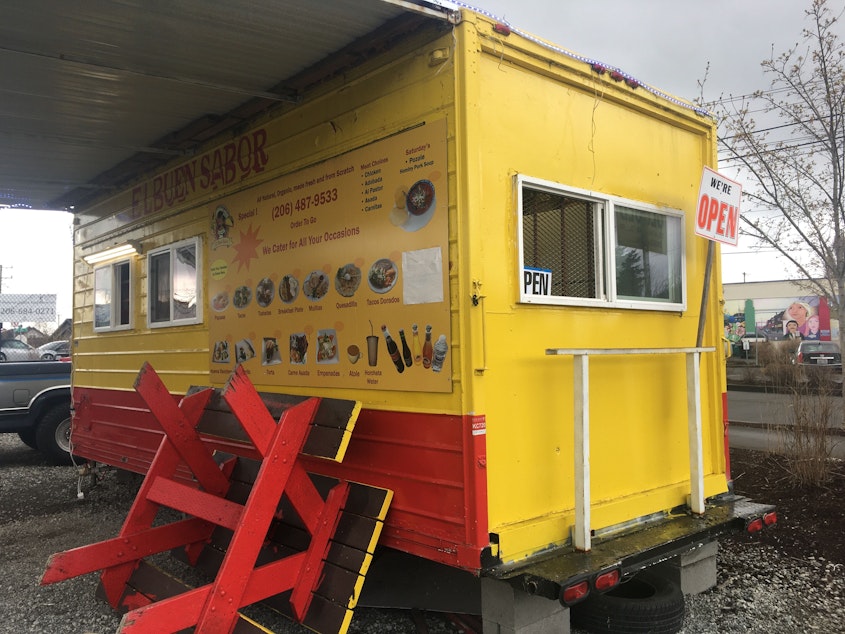Seattle's food truck future: Today So Far

- Seattle is reconsidering its food truck regulations.
- Today So Far taking a vacation.
This post originally appeared in KUOW's Today So Far newsletter for August 26, 2022.
As Seattle further emerges from the pandemic, I have a hopeful vision of city life. I would love to see a city where some people work from home, or have a hybrid schedule, living in corners of Seattle that are more affordable. And while they are home, they are able to walk down the street to a food truck for lunch, or dinner, or late night munchies.
I'm going to annoy some TSF readers with this statement, but when I lived in Portland (it's OK, I won't mention that city again ... breathe) many years ago, it was pretty easy to grab a bite en route to work, class, or a friend's place. Food trucks were tucked into various corners of the city. An array of innovative, fun, and convenient food was accessible. Upon moving back north, one criticism I had of Seattle, it's that I wished there were more food trucks. The trucks we have are awesome. Why wouldn't we want more?
As KUOW's Ruby de Luna reports, Seattle is reconsidering many of its regulations around food trucks with the aim of making a better business environment for them. These rules have been in place since 2011. But the Seattle Department of Transportation noticed they didn't make much sense during pandemic times (they didn't make much sense in 2011 either, in my opinion), so SDOT modified food truck rules over the past couple years to make things a bit easier. Now, SDOT is looking to update the city's approach to food trucks when these modifications expire in 2023. In short, it wants to "streamline" the food truck process and offer "one-on-one coaching" for businesses.
"I think if SDOT can bring down the street vending permit fees, you should see more food truck activity in the streets of Seattle," said Lori Johnson, executive director of the Washington State Food Truck Association.
"Before SDOT decided to change the regulations, they weren't allowing more than two food trucks per block face, that's why you weren't seeing many of them grouped together," she added. "And it's super hard, and super expensive, to find private property to group them together."
Sponsored
If you're a food truck in Seattle, you can find a plot of private property, in a decent corner of the city, with plenty of foot traffic and customers, to set up shop. Or you can go through the city to find a public spot to dish up. But this is Seattle, so either of those options are going to come with hefty price tags. Either the private landowner is going to want sky-high rent (or what some would laughably call "market rate"), or the city is going to want sky-high fees, but that will hopefully change as SDOT evolves into 2023.
Among the changes SDOT is proposing, that limit of two food trucks per block will be nixed. Also, restrictions that push trucks 50 feet away from buildings will be gone. And a ban on food trucks from being within 1,000 feet of a high school will go away.
Further changes for street vending will go beyond food trucks and influence outdoor dining alongside restaurants. And they will open up street-side vending to businesses outside of food, like flowers and crafters.
There's one other piece of not-news that I want to address with all the TSF readers out there.
Here's the thing: Nina and I eloped in 2020. Two years later, we're going to have a honeymoon. So in other words, I'm going to be away and Today So Far will be taking a break for a couple weeks.
Sponsored
But here's another thing: I think we should use this time to turn the tables. I use this newsletter to highlight KUOW's work and provide some nuance for stories that is more often discussed around a water cooler (does that still happen?). And I provide some original reporting from time-to-time. Can you do the same? While I'm away, send me the stories you find interesting on KUOW.org, and tell me why they are interesting or important to you. What is the context around your news? In a way, you'll take the helm of Today So Far, and I'll do a round up when I get back. Email me at dyer@kuow.org. I look forward to seeing how you engage!
AS SEEN ON KUOW

Seattle's Whim W'him is performing a series of outdoor dance performances this summer, inspired by the pandemic. “TOUCHED” explores the ways we come together to support each other as we move through this point in time. (Whim W'him)
DID YOU KNOW?
Sponsored
It is difficult to pinpoint exactly when the first food truck emerged. It was likely an evolution that involved a few factors. There was the chuckwagon back in the 1800s, which served food out of a covered wagon. Eventually, companies were producing professional covered wagons with the sole purpose of making food. The U.S. military began outfitting vehicles with kitchens in the early 1900s.
There is an argument that the first vehicle our modern eyes would consider a "food truck" rolled out in 1936 — the Wienermobile. Oscar Meyer developed this roving car shaped like a hot dog to promote its wieners across the USA, and hot dogs began being served on four wheels far and wide. And it's still rolling to this day.
ALSO ON OUR MINDS

Sponsored
The western U.S. hasn't been this dry for more than 1,200 years, but 30 western coal plants continue to suck up 156 million gallons a day of the region's scarce water, according to the Energy Information Administration. Now the very plants whose emissions help drive climate change are at risk of shutdowns, because the water they need to operate has fallen to unprecedented levels.

